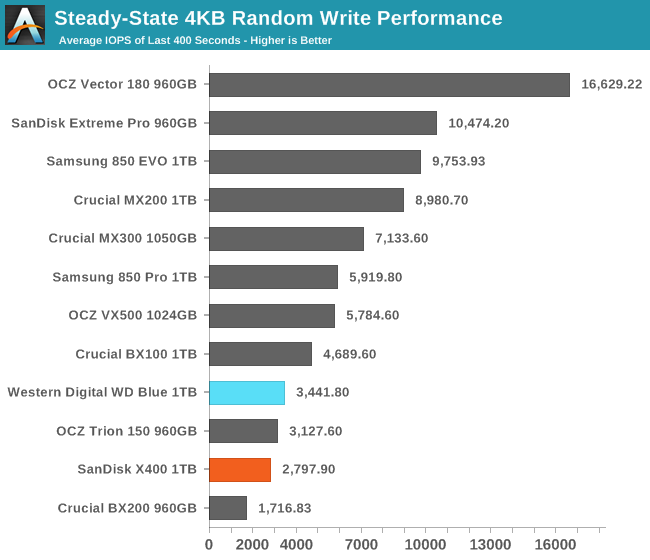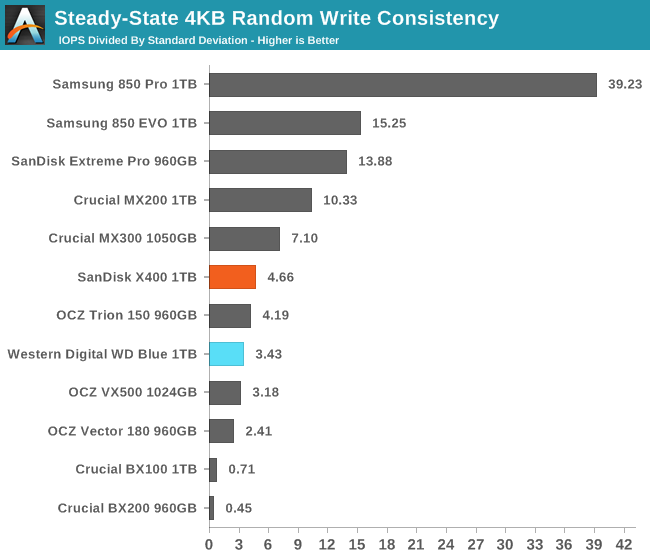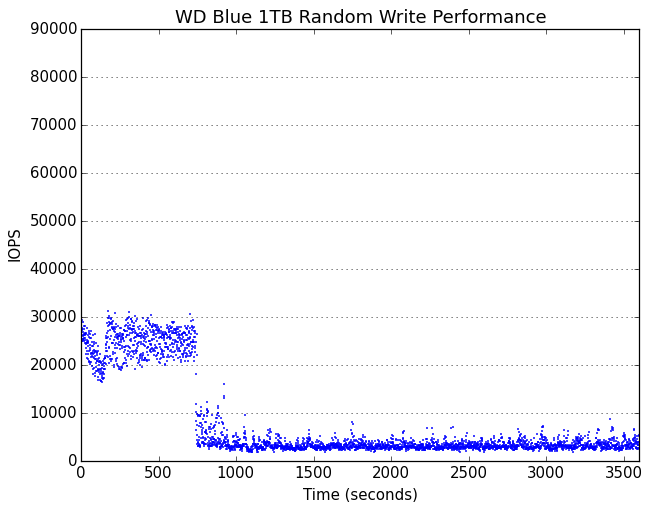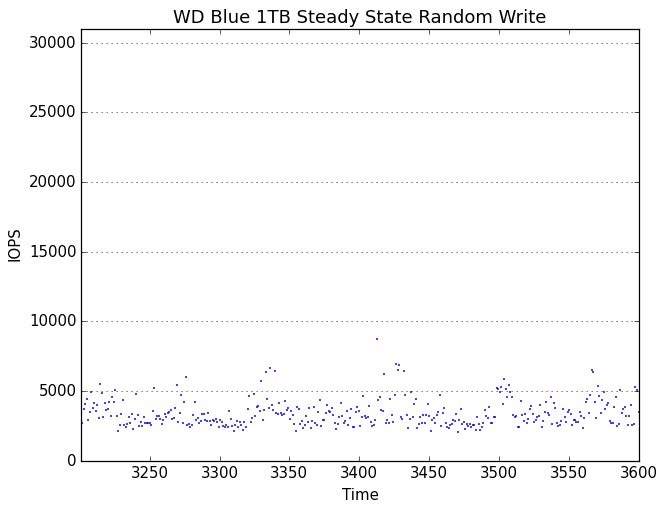The Western Digital Blue (1TB) SSD Review: WD Returns to SSDs
by Billy Tallis on October 11, 2016 8:00 AM EST- Posted in
- SSDs
- Storage
- Western Digital
- SanDisk
Performance Consistency
Our performance consistency test explores the extent to which a drive can reliably sustain performance during a long-duration random write test. Specifications for consumer drives typically list peak performance numbers only attainable in ideal conditions. The performance in a worst-case scenario can be drastically different as over the course of a long test drives can run out of spare area, have to start performing garbage collection, and sometimes even reach power or thermal limits.
In addition to an overall decline in performance, a long test can show patterns in how performance varies on shorter timescales. Some drives will exhibit very little variance in performance from second to second, while others will show massive drops in performance during each garbage collection cycle but otherwise maintain good performance, and others show constantly wide variance. If a drive periodically slows to hard drive levels of performance, it may feel slow to use even if its overall average performance is very high.
To maximally stress the drive's controller and force it to perform garbage collection and wear leveling, this test conducts 4kB random writes with a queue depth of 32. The drive is filled before the start of the test, and the test duration is one hour. Any spare area will be exhausted early in the test and by the end of the hour even the largest drives with the most overprovisioning will have reached a steady state. We use the last 400 seconds of the test to score the drive both on steady-state average writes per second and on its performance divided by the standard deviation.

With a slight increase in out of the box overprovisioning, it is unsurprising to see the WD Blue improve on the SanDisk X400's steady-state random write performance. The WD Blue overtakes the OCZ Trion 150 as the fastest planar TLC NAND SSD, but doesn't catch up to the MLC or 3D TLC drives.

The WD Blue has slightly worse performance consistency than the X400, but not low enough to be cause for concern.
 |
|||||||||
| Default | |||||||||
| 25% Over-Provisioning | |||||||||
Before reaching steady state, the WD Blue hovers between 20k and 30k IOPS, a significant improvement over the X400. Several other competitors have higher peak performance, but are either less consistent during the early phase of the test or don't last as long before dropping to steady state.
 |
|||||||||
| Default | |||||||||
| 25% Over-Provisioning | |||||||||
Upon reaching steady state, the WD Blue varies from roughly 2500 IOPS to 5000 IOPS, with short bursts of slightly higher performance. With extra overprovisioning the base performance of the WD Blue doesn't change but the upper limit of its normal band of performance increases to around 10k IOPS and the peaks reach 25k.










75 Comments
View All Comments
Arbie - Tuesday, October 11, 2016 - link
I agree with another comment. Why is the Mushkin Reactor 1TB not in the charts for recent SSD reviews? At $230 it's cheaper than many, is MLC, and overall seems like a great buy. You reviewed it but then seem to have forgotten it.DanNeely - Tuesday, October 11, 2016 - link
I'm a bit puzzled by the performance consistency numbers here. In them the WD Blue 1TB seems to be consistently faster than the Sandisk X400 1TB before reaching steady state and about the same speed once it hits that point; but in almost all the other benches the Sandisk scores higher.Billy Tallis - Tuesday, October 11, 2016 - link
The drive is completely filled once before the random write consistency test, which runs at QD32. Most of the other IOmeter scores are averages of low queue depths, and the random write test on page 6 is limited to a 16GB test file on an otherwise empty drive. Whatever effect caused the WD Blue to have lower peak performance is more significant for the shorter test, while for the consistency test the fact that the WD Blue has more spare area to start with than the X400 is a bigger factor.kmmatney - Tuesday, October 11, 2016 - link
I bought a SanDisk Ultra II 960GB drive about a year ago for around $200, and it's still close to that price ($219 at the moment). It's the one with SLC cache - I use it in my everyday work computer, as my OS drive, and I typically run 1-2 virtual machines as well. So I push it fairly hard for a consumer SSD, and it still runs great - no complaints at all, and I'd recommend it for the price.Michael Bay - Thursday, October 13, 2016 - link
Same experience here. In a few weeks it will be a year of use for me, and if Sandisk utility is to be trusted, it`s only 1% worn.mapesdhs - Friday, October 14, 2016 - link
It's a pity the X300 is not available anymore, it had very good consistency and at one point was cheaper than many budget models.Shadowmaster625 - Tuesday, October 11, 2016 - link
It is amazing that they fit all that on one side of the board without so much as a capacitor on the back...LordConrad - Tuesday, October 11, 2016 - link
Sorry, I refuse to buy a SSD that uses TLC planar NAND.TheinsanegamerN - Tuesday, October 11, 2016 - link
why? these have higher write endurance then some MLC drives.MrCommunistGen - Tuesday, October 11, 2016 - link
That was quick - WD releasing an SSD under their own name. Sure it is a warmed over X400, but as the performance numbers indicate they didn't just slap a sticker on it... which leads to my next comment.When I read the opening of the article I was pretty excited. X400 with a bit more overprovisioning. I was expecting to see extra performance (even if only a little) along with the endurance. I guess not. Oh well.